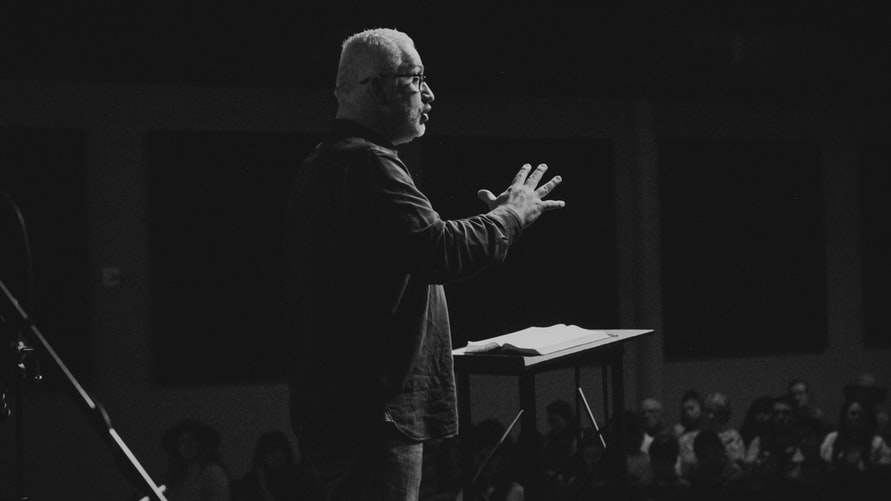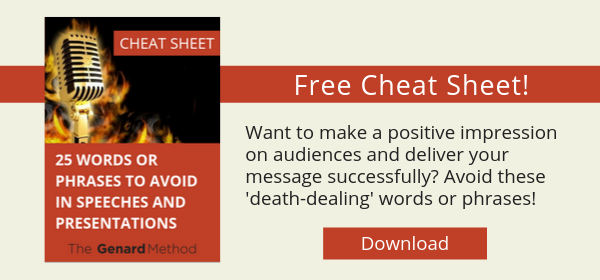
Do you know how to move audiences, rather than just read your material? Here's how to speak from notes or a manuscript in public speaking.
Think it's difficult to read from notes or a manuscript and still relate to a public speaking audience?
It isn't, really. Why then do so many people do it badly? Keynote speaking, motivational speeches, pitching business, or contributing to a meeting are all examples of the same transaction: someone sharing important information, and others listening. Obviously, it can’t help to have a closer relationship with one's speaking notes than with the audience. But that's exactly what we see in too many presenters.
If you want to influence listeners, you must establish rapport with them. After all, are you persuaded by someone whose attention seems to be elsewhere when they're talking to you?
The words you say matter as well. Learn about the language that limits your success! Get my free white paper, "25 Words or Phrases to Avoid in Speeches and Presentations."
To be an effective presenter, then, you need to be able to gather your thoughts from a page, yet appear to be speaking without any notes at all. Below are six practical tips for doing so—that is, for performing effectively while using a manuscript, notes, PowerPoint, or other speaking aid.

How to Be a More Dynamic Public Speaker
1. Write to Speak. Compose your talk for the ears—not the eyes—of your listeners. Aim for the rhythms of conversation rather than the more formal style of memos and reports or the barely-composed slang of e-mail. That means using simple words and short sentences. Use a tape recorder and listen to yourself to improve in this area. If it's inspiration you need, wrap your headphones around any speech by Winston Churchill. (Here are powerful techniques you can use to speak for leadership.) The idea is to make your words conversational, and therefore easy for you to access.
2. Make it Readable. Give yourself pages of typeface (or handwriting) that are easy to see from the lectern. Use a 16-point sans serif typeface like Arial, and triple-spacing. Avoid printing near the bottom of the page, or your audience will see the top of your head too often. When you finish a page, slide that page face up on top of the page that preceded it. It's less distracting for your audience than if you flip the pages over in the air.
3. Grab Key Phrases: You don’t want to spend more time with your text than with your listeners. So look down and “grab” a key phrase or idea. Then look up and say it. This is actually easier than it sounds. Practice it so you acquire a rhythm, an essential skill of public speaking. Remember this important rule: If you’re not looking at your audience, nothing should be coming out of your mouth. Especially resist the temptation to look for what's coming next while you're still talking about the current point.
4. Use 'The Pause That Refreshes'. That’s a slogan from an old soft drink ad. But it applies equally well for you as a speaker, because you have to learn to use pauses! They help shape your speech. They show that you’re confident enough to let an idea sit still long enough to sink in. Pauses are refreshing for audiences. A speech without pauses seems to go on forever, regardless of its actual length. Combine this skill in pacing with these 5 key tools of vocal dynamics to be a more powerful speaker.
5. Make Eye Contact. This is the forest that many speakers don’t see because of the trees that made up the pages of their manuscript. Get in the habit of looking up from your speech with every sentence. Audiences need eye contact to believe you’re talking to them. So yes, eye contact is central to influence. Here's more advice on how to begin a presentation, especially in the critically important first 60 seconds.
6. Hit Your Peaks. Your speech needs shape in both ideas and delivery. A speech without a climax, for instance, is as formless as an amoeba; and presentations without vocal variety are sheer torture to the ear. The tendency of your voice to “flatten out” increases when you read from notes or a manuscript rather than actually talking to listeners. Audiences demand much more from a speaker than someone who just reads lines on a page. Your job is to breathe life into those words. Your listeners will love you for it, and wonder where you were if you don't.
Key takeaways from this blog:
- It's easy to read from a manuscript while still relating to your listeners.
- Compose your talk for the ears, not the eyes, of your listeners.
- If you're not looking at your audience, nothing should come out of your mouth.
- Despite nervousness, you must pause long enough for ideas to sink in.
- Breathe life into the words, and emphasize the high point of your speech.
This article was originally published in 2015. It is updated here.
You should follow me on Twitter here.



